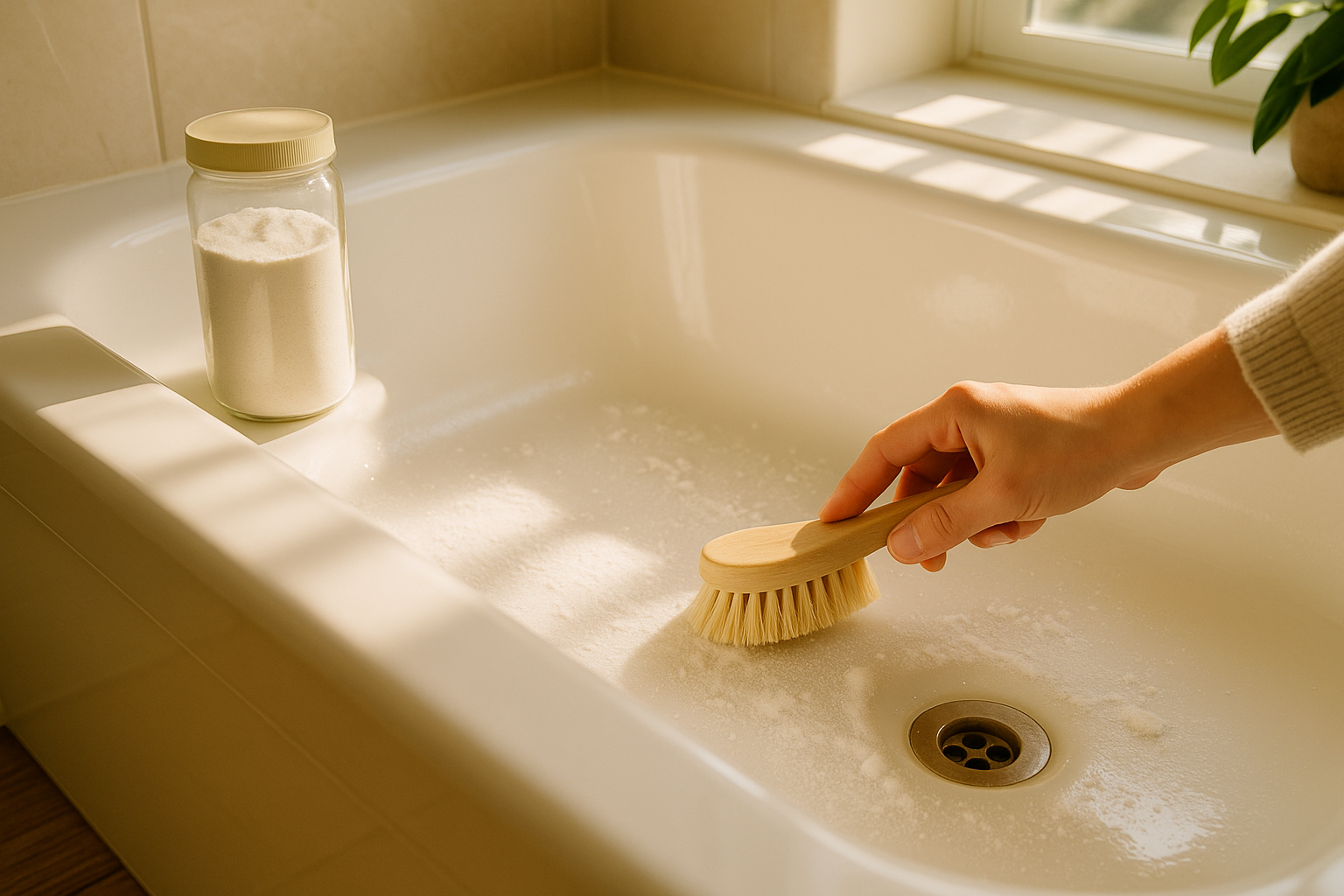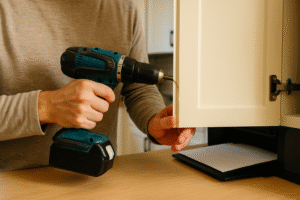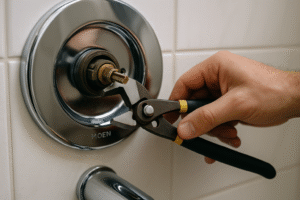Introduction: Why Bathtub Baking Soda Matters
When it comes to affordable, eco-friendly, and effective cleaning solutions, few household items are as versatile as baking soda. In bathrooms, one of the most common uses is for refreshing and cleaning tubs. Learning how to use bathtub baking soda methods is an excellent way to maintain hygiene, prevent chemical exposure, and save money compared to commercial cleaning products. This simple ingredient, often sitting in your pantry, can tackle stains, odors, soap scum, and even mild clogs without harsh effects on your health or the environment.
Unlike many chemical cleaners that release strong fumes and can be abrasive on delicate surfaces, baking soda offers a gentle yet powerful cleaning action. Its mild alkalinity breaks down grease, soap residue, and mineral buildup commonly found in tubs, while its natural deodorizing properties eliminate unpleasant smells. Whether you have a porcelain, acrylic, or fiberglass tub, bathtub baking soda cleaning is safe and effective when used correctly.
The popularity of eco-friendly cleaning practices continues to grow, and baking soda stands out as one of the most reliable natural options. Using bathtub baking soda cleaning not only contributes to a healthier home environment but also reduces your reliance on disposable plastic bottles of chemical cleaners. Over time, these small changes add up, supporting a sustainable lifestyle and lowering household expenses. In this guide, you’ll learn the tools you need, step-by-step instructions, common mistakes to avoid, and expert tips that ensure your tub remains sparkling clean with nothing more than baking soda.
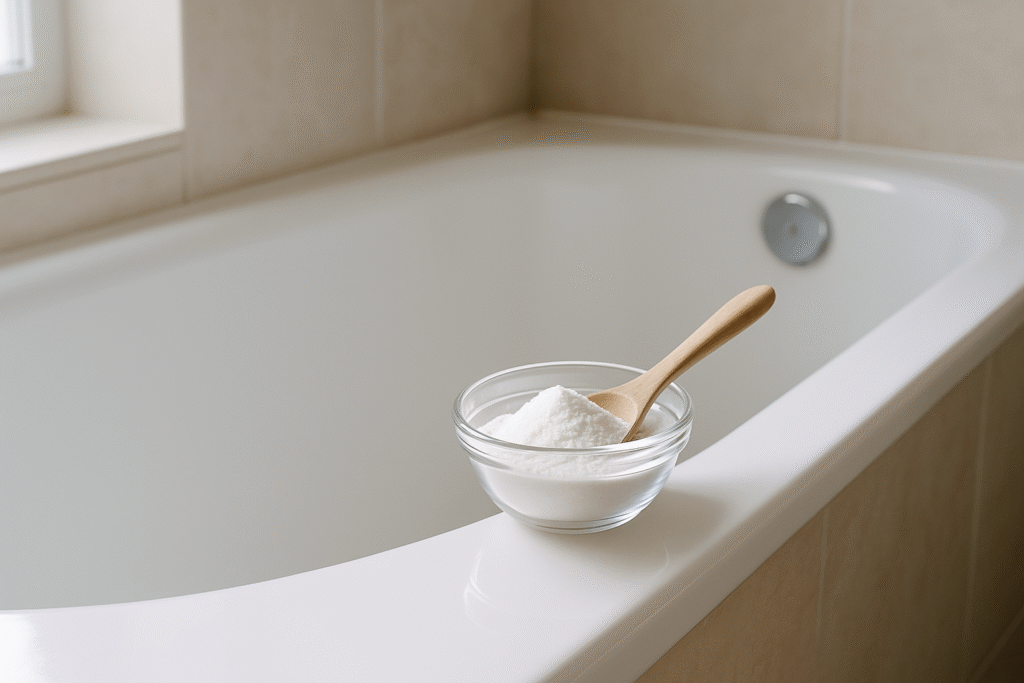
What You’ll Need Before You Start
Before using bathtub baking soda methods for cleaning or deodorizing, it’s important to prepare the right tools and supplies. Gathering everything in advance makes the process smooth and prevents interruptions once you begin. Fortunately, this method relies on simple household items that are affordable and safe to use, eliminating the need for harsh chemical cleaners.
The star ingredient is, of course, baking soda. For a full bathtub cleaning, plan on using one to two cups of baking soda depending on the severity of stains and buildup. To enhance its effectiveness, many people also pair it with white vinegar. When combined, the fizzing reaction helps lift soap scum, loosen grime, and neutralize odors. While vinegar is optional, it’s a powerful companion that boosts the results of bathtub baking soda cleaning.
In terms of tools, you’ll need a soft sponge or non-abrasive scrub brush to avoid scratching the tub’s surface. Microfiber cloths are ideal for wiping down surfaces after cleaning. A small bucket or measuring cup will help you sprinkle baking soda evenly across the tub, while a spray bottle filled with water or vinegar can make application easier. For tough stains, having a plastic scraper on hand can help lift residue without damaging the surface.
Finally, don’t forget safety and comfort. Wear rubber gloves to protect your skin from prolonged contact with baking soda and vinegar. Good ventilation is also recommended, especially if you use vinegar, as the smell can be strong in enclosed spaces. By gathering these materials beforehand, your bathtub baking soda cleaning session will be efficient, safe, and highly effective.
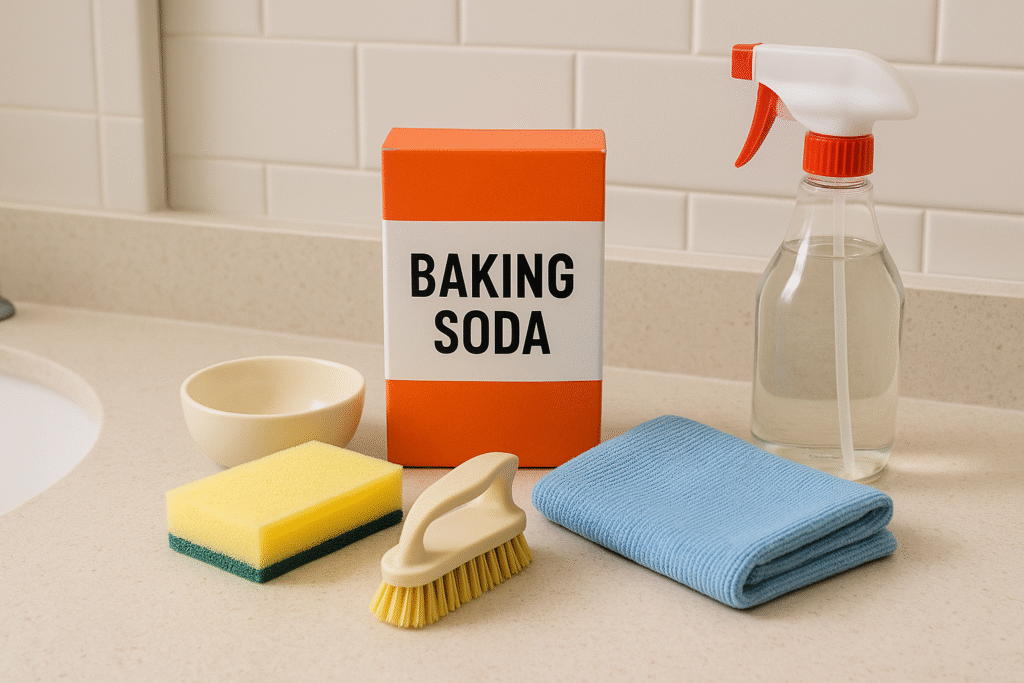
Step 1: Sprinkle Baking Soda Evenly Across the Tub
The first step in the bathtub baking soda method is applying the ingredient evenly across the tub’s surface. This ensures consistent coverage so the cleaning action can target stains, odors, and soap scum effectively. Begin by rinsing the bathtub lightly with warm water to dampen the surface—this helps the baking soda stick rather than sliding off into the drain. Avoid using too much water, as the goal is only to create a moist base for the powder to cling to.
Next, measure about one cup of baking soda for a standard cleaning, or up to two cups for a heavily stained tub. Hold a small container or measuring cup filled with baking soda and gently sprinkle it across the bathtub. Focus on areas that accumulate the most residue, such as the bottom where water pools and along the sides where soap scum tends to build. By spreading it evenly, you maximize the contact between the baking soda and the dirt you want to remove.
For even better results, let the baking soda sit undisturbed for 5–10 minutes after application. This waiting period allows the mild alkalinity of the powder to start loosening grime. It’s also a good time to prepare any additional supplies, such as a spray bottle filled with water or vinegar, which can be used in the next step to activate the fizzing reaction. The key here is patience—giving baking soda time to settle enhances its cleaning and deodorizing potential.
This simple yet effective step forms the foundation of the entire bathtub baking soda cleaning process. A proper, even application ensures your tub receives a thorough cleaning and reduces the need for aggressive scrubbing later on.
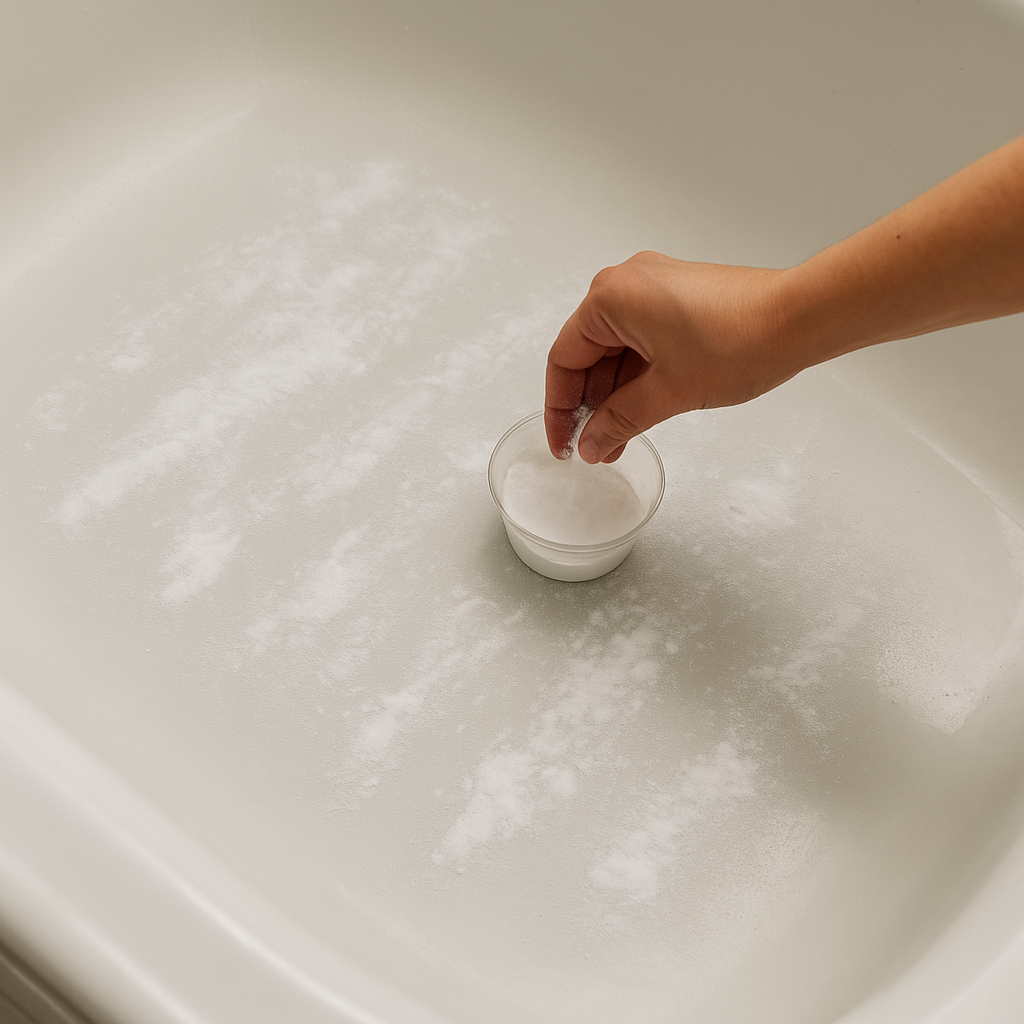
Step 2: Activate with Water or Vinegar
After sprinkling baking soda across the surface, the next step in the bathtub baking soda cleaning process is to activate it with water or vinegar. This step transforms baking soda from a simple powder into a powerful cleaning agent that can lift grime, neutralize odors, and dissolve soap scum. For light cleaning, a simple mist of warm water is sufficient. Spray the entire surface evenly so that the powder becomes slightly pasty, which helps it cling to dirt and buildup on the tub walls and bottom.
For deeper cleaning, especially in tubs with visible stains or mineral deposits, vinegar is the best option. Fill a spray bottle with equal parts white vinegar and water, then mist it generously over the baking soda. The reaction between the two creates fizzing bubbles that actively break down residue. This chemical reaction is completely safe and non-toxic, yet highly effective for tackling tough grime. The fizzing action also works its way into small crevices, giving you a more thorough clean.
Let the mixture sit for 10–15 minutes while it works. This resting period allows the baking soda and vinegar to penetrate dirt and loosen stains, reducing the need for hard scrubbing. During this time, the natural deodorizing properties also eliminate any lingering odors from the tub, leaving it fresh and clean.
By activating the bathtub baking soda with water or vinegar, you amplify its cleaning power and prepare the surface for scrubbing in the next step. It’s a safe, eco-friendly way to restore your bathtub’s shine without relying on harsh chemical products.
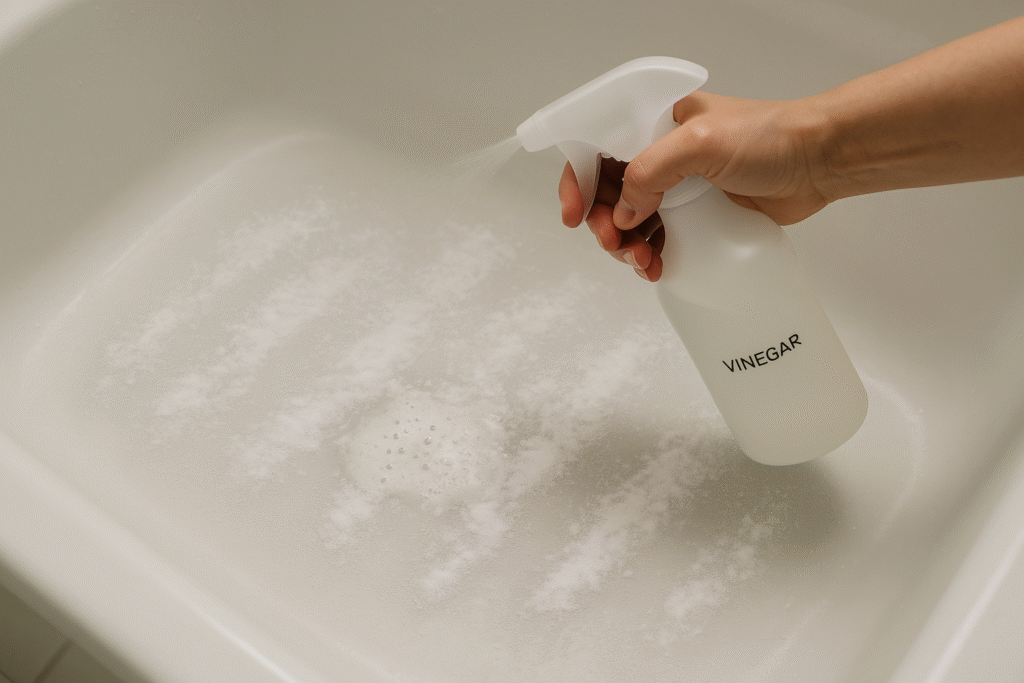
Step 3: Scrub and Rinse Thoroughly
Once the bathtub baking soda has been activated with water or vinegar and allowed to sit, the next step is scrubbing the surface to remove dirt and buildup. Using a non-abrasive sponge or a soft scrub brush, begin working in circular motions across the tub. Start with the bottom where grime is most concentrated, then move up the sides, paying extra attention to corners and edges where soap scum and mineral deposits collect. The slightly gritty texture of baking soda provides gentle abrasion that loosens stubborn stains without scratching porcelain, acrylic, or fiberglass surfaces.
If you’re dealing with more challenging spots, apply a little extra baking soda directly to the sponge and focus on those areas with firm, steady pressure. For drains or overflow areas that often develop discoloration, scrubbing with a paste of baking soda and water works especially well. Avoid using steel wool or overly rough pads, as they can damage the tub’s finish, leaving behind scratches that make future cleanings harder.
After scrubbing the entire surface, it’s time to rinse. Use warm water to flush away the loosened dirt, baking soda residue, and any vinegar solution left behind. A detachable showerhead makes this process easier, but if you don’t have one, simply use a large cup or bucket to pour water evenly across the surface. Ensure no powder remains, as leftover baking soda can create streaks or a chalky residue once dry.
By finishing with a thorough scrub and rinse, the bathtub baking soda cleaning process leaves your tub spotless, fresh-smelling, and ready for use. This final step ensures all buildup is removed and restores the shine of your bathtub without relying on harsh chemicals.
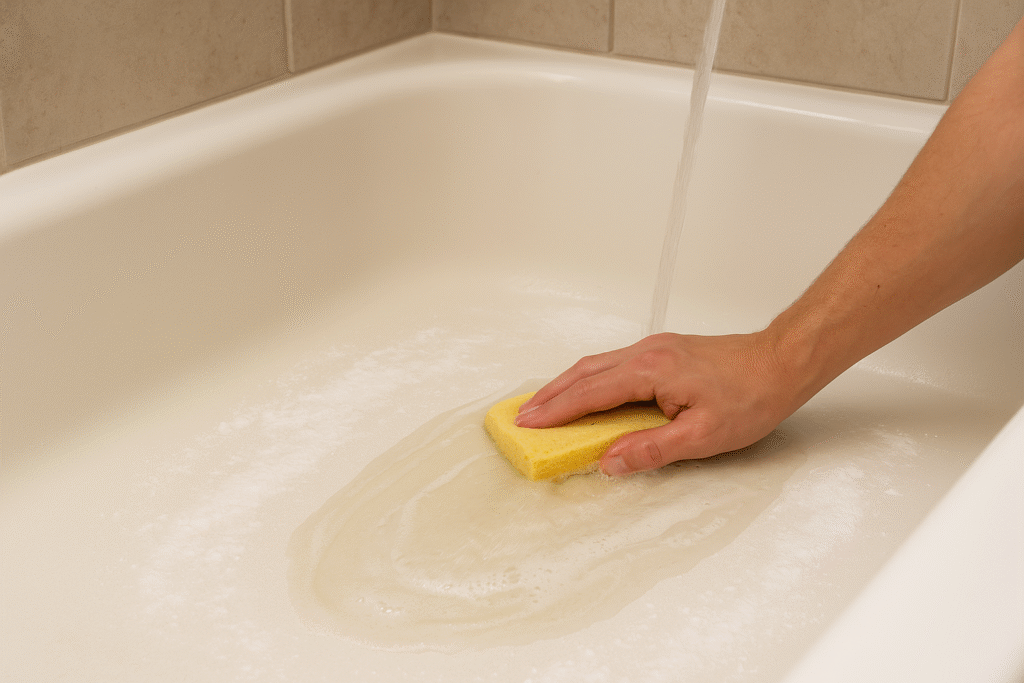
Common Mistakes to Avoid When Using Bathtub Baking Soda
Although bathtub baking soda cleaning is simple and effective, there are common mistakes that can reduce its effectiveness or even cause unintended problems. One frequent error is applying too much baking soda in one spot instead of spreading it evenly. Over-concentration can lead to clumping, making scrubbing harder and leaving behind a chalky residue that takes longer to rinse away. Always sprinkle it uniformly across the tub for the best results.
Another mistake is scrubbing with abrasive tools. While baking soda is gentle, pairing it with rough scrubbers like steel wool can scratch bathtub surfaces, particularly acrylic or fiberglass tubs. These scratches may not only look unattractive but can also trap dirt and soap scum, making the tub harder to clean in the future. Stick with non-abrasive sponges or brushes designed for delicate surfaces.
Some homeowners also make the error of not giving the baking soda enough time to sit before scrubbing. Allowing it to rest for 5–10 minutes (or longer when combined with vinegar) is essential for loosening grime. Rushing this step reduces its cleaning power and often means more elbow grease later on. Similarly, failing to rinse thoroughly after cleaning can leave a thin film of powder, which looks dull and may cause slipperiness when the tub is used.
Finally, avoid mixing bathtub baking soda directly with strong commercial cleaners, especially those containing bleach. Combining these products can cause chemical reactions that are harmful to both surfaces and your health. For safety and effectiveness, stick with natural pairings such as vinegar or mild dish soap. By steering clear of these mistakes, your bathtub cleaning will be safer, quicker, and more effective.
Alternative Methods for Using Bathtub Baking Soda
While the traditional method of sprinkling, activating, and scrubbing is the most common, there are several alternative approaches to using bathtub baking soda that can address specific problems. One popular method is creating a baking soda paste by mixing three parts baking soda with one part water. Apply this thick mixture directly to stubborn stains, rust spots, or soap scum buildup. Let it sit for 15–20 minutes before scrubbing for targeted cleaning power. This paste method is especially effective for spot treatments without needing to clean the entire tub.
Another alternative is combining baking soda with mild dish soap to enhance degreasing action. Mix one tablespoon of liquid dish soap with half a cup of baking soda to create a foamy cleaner. Apply it to greasy or oily stains that plain baking soda struggles to remove. For tubs that need deodorizing, sprinkle baking soda across the wet surface and then add a few drops of essential oils such as lavender, lemon, or eucalyptus. This not only cleans the tub but also leaves behind a fresh, pleasant fragrance.
For clogged or slow drains, bathtub baking soda can also play a role. Pour half a cup of baking soda directly into the drain, followed by a cup of vinegar. Allow the mixture to fizz for 10–15 minutes, then flush it with boiling water. This method helps clear minor blockages and reduces odors without resorting to harsh chemical drain cleaners.
Lastly, for routine maintenance, add a cup of baking soda to a tub filled with warm water and let it soak for 30 minutes before draining. This quick soak helps loosen light grime and keeps the bathtub fresh between deeper cleanings. These alternative methods demonstrate how versatile bathtub baking soda can be in maintaining a clean, odor-free bathroom.
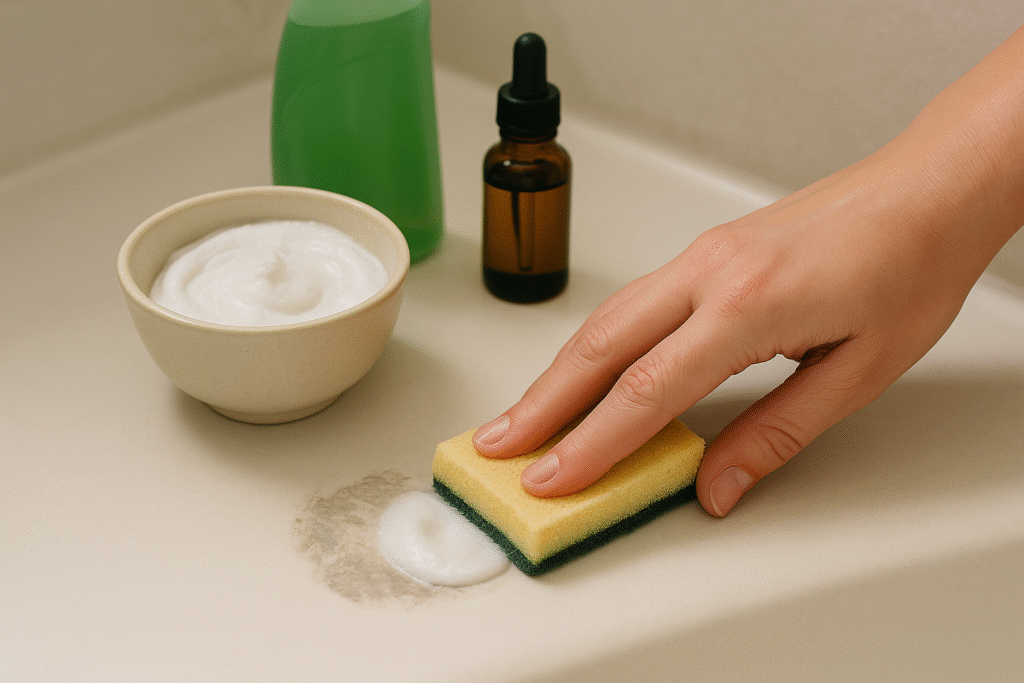
Expert Tips and Best Practices
When using bathtub baking soda for cleaning, a few expert tips can maximize results and make the process more efficient. First, always test a small, inconspicuous area of your tub before applying baking soda to the entire surface. While generally safe, some specialty finishes or coatings may react differently. This precaution ensures you won’t cause accidental dulling or surface damage.
For best results, pair baking soda with warm water during your cleaning routine. Warm water enhances the dissolving action of baking soda and helps loosen grime more quickly. If combining with vinegar, apply the vinegar gradually using a spray bottle rather than pouring it directly onto the powder. This controlled method prevents excessive fizzing and ensures the cleaning action is spread evenly across the tub.
Experts also recommend regular maintenance rather than waiting for heavy buildup. Sprinkling a light layer of baking soda and rinsing weekly prevents soap scum and odors from accumulating, keeping the tub fresher for longer. To maintain shine, follow up with a microfiber cloth after rinsing to buff the surface gently. This small step reduces water spots and leaves the bathtub looking polished.
Finally, consider eco-friendly combinations. Mixing bathtub baking soda with natural ingredients like lemon juice or essential oils adds antibacterial and deodorizing properties while keeping your bathroom smelling fresh. For additional guidance, check resources like the EPA Safer Choice program, which highlights safe household cleaning practices. By applying these best practices, you ensure that your baking soda cleaning routine is effective, safe, and environmentally responsible.
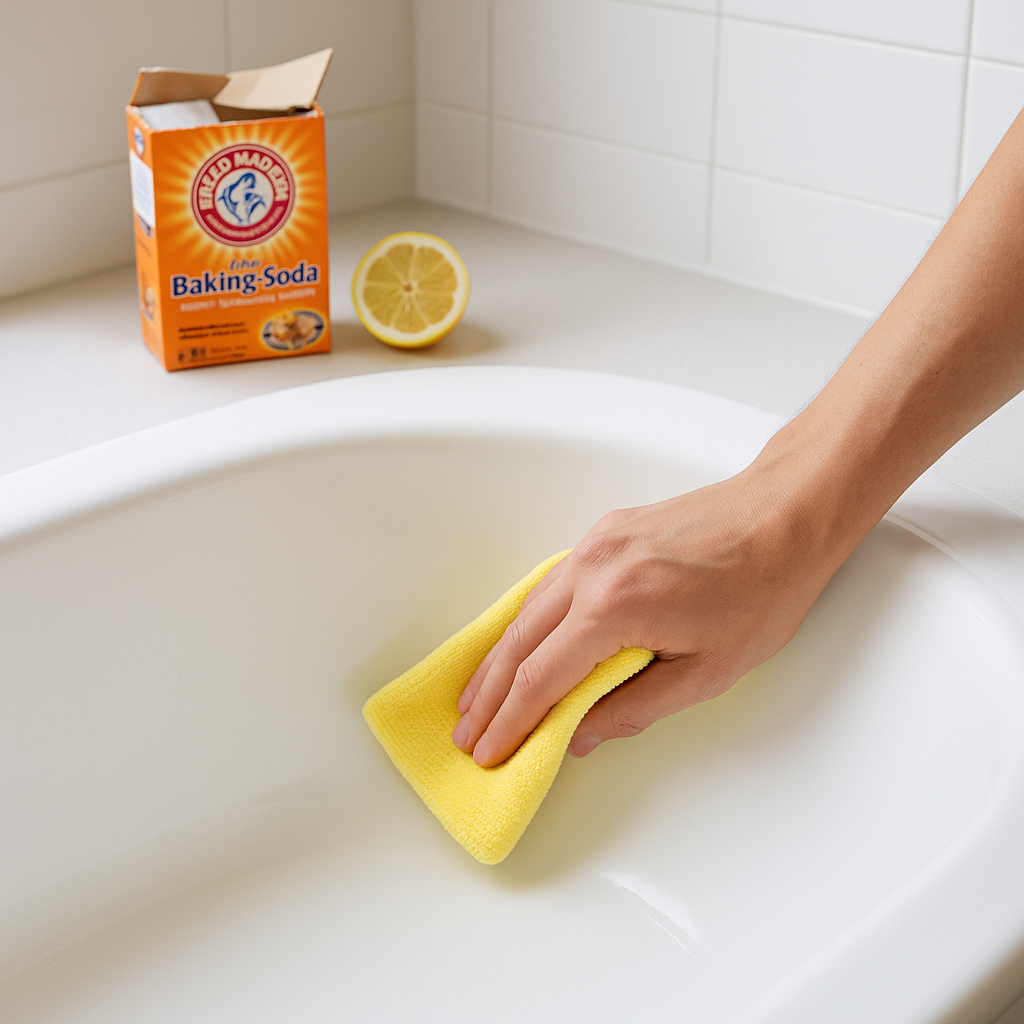
Frequently Asked Questions About Bathtub Baking Soda
When it comes to cleaning with natural products, many people have questions about how bathtub baking soda works, whether it’s safe, and how effective it really is. Below are answers to the most common questions homeowners ask before making the switch from commercial cleaners to baking soda.
Is baking soda safe for all types of bathtubs?
Yes, baking soda is safe for most bathtub materials, including porcelain, acrylic, and fiberglass. Its mild abrasiveness cleans without scratching. However, always test a small, hidden area first, especially on specialty finishes or coatings.
Can I mix baking soda with bleach for extra cleaning power?
No. Mixing bathtub baking soda with bleach can cause harmful chemical reactions. Instead, pair baking soda with vinegar, lemon juice, or mild dish soap for safe and effective cleaning.
How often should I clean my tub with baking soda?
For regular maintenance, a light sprinkle and rinse once a week keeps the tub fresh and prevents buildup. For deeper cleaning, repeat the full process every 2–3 weeks depending on usage and water hardness.
Will baking soda remove tough stains like rust?
Baking soda can help with mild rust stains, but for heavy rust, you may need specialized cleaners. A paste of baking soda and water left on the stain for 20 minutes is often effective on lighter marks.
Does using baking soda really deodorize the bathtub?
Yes, one of the best features of bathtub baking soda is its natural deodorizing ability. It neutralizes odors without masking them with artificial scents, leaving the bathroom smelling fresh.
For additional natural cleaning guidance, you can refer to resources like the Good Housekeeping Cleaning Guide, which often features baking soda methods.
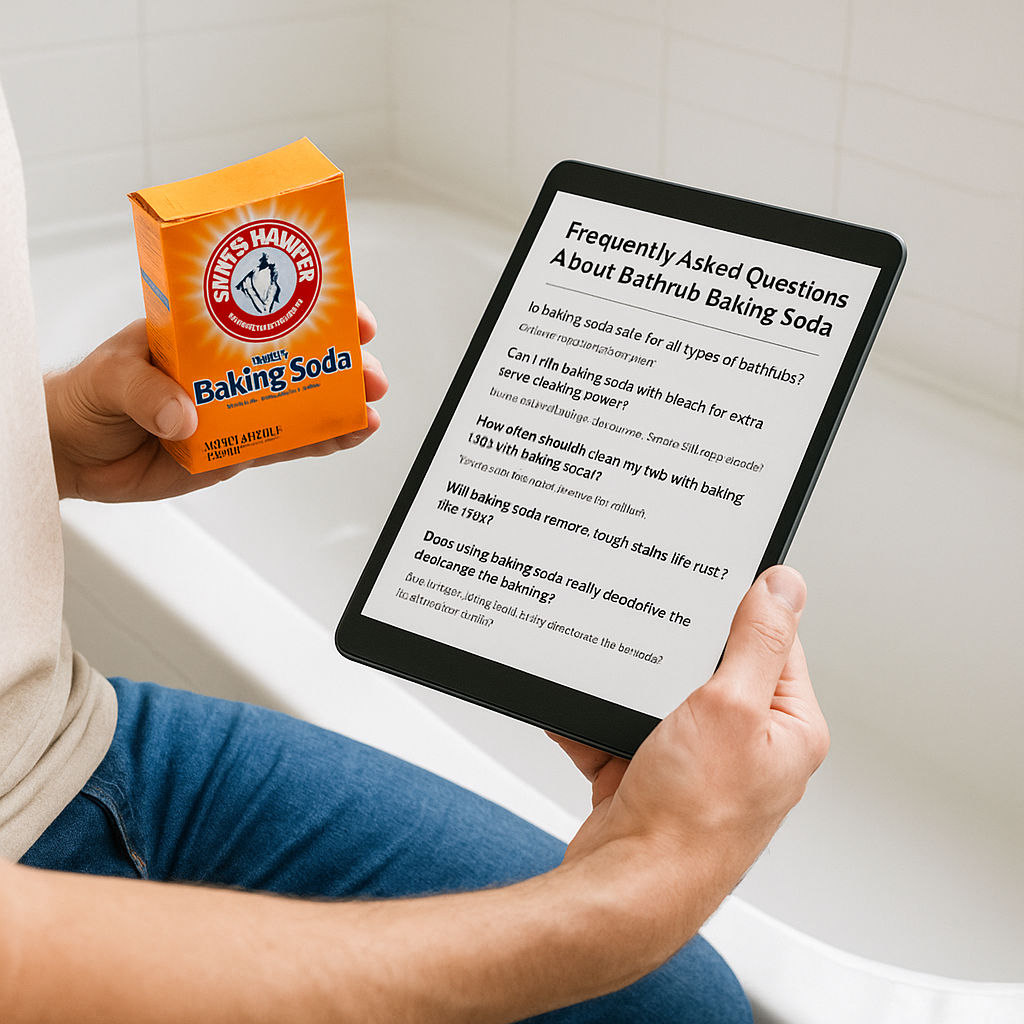
Conclusion: Putting It All Together
Cleaning with bathtub baking soda is one of the simplest, most effective, and eco-friendly ways to maintain a sparkling bathroom. By sprinkling, activating, scrubbing, and rinsing, you can remove soap scum, stains, and odors without relying on harsh chemical cleaners. Alternative methods like making a baking soda paste, pairing it with dish soap, or using it to freshen drains further showcase its versatility in keeping your bathtub and bathroom in excellent condition.
Beyond cleaning power, baking soda offers the added benefit of safety. It’s non-toxic, inexpensive, and widely available, making it accessible to every household. Families with children, pets, or sensitive skin especially appreciate how bathtub baking soda eliminates the need for strong-smelling chemical cleaners. Its natural deodorizing properties ensure your tub not only looks clean but smells fresh too.
By following the expert tips and best practices in this guide—such as regular maintenance, using warm water, and pairing with natural ingredients—you can maximize the effectiveness of your cleaning routine. Avoiding common mistakes, like overusing or combining with harsh chemicals, ensures your bathtub’s surface stays in great condition for years to come.
In the end, bathtub baking soda proves that the best solutions are often the simplest. With just a few cups of powder and a little effort, you can achieve professional-level results, save money, and create a healthier home environment. It’s a small habit that makes a big difference in bathroom care and sustainable living.
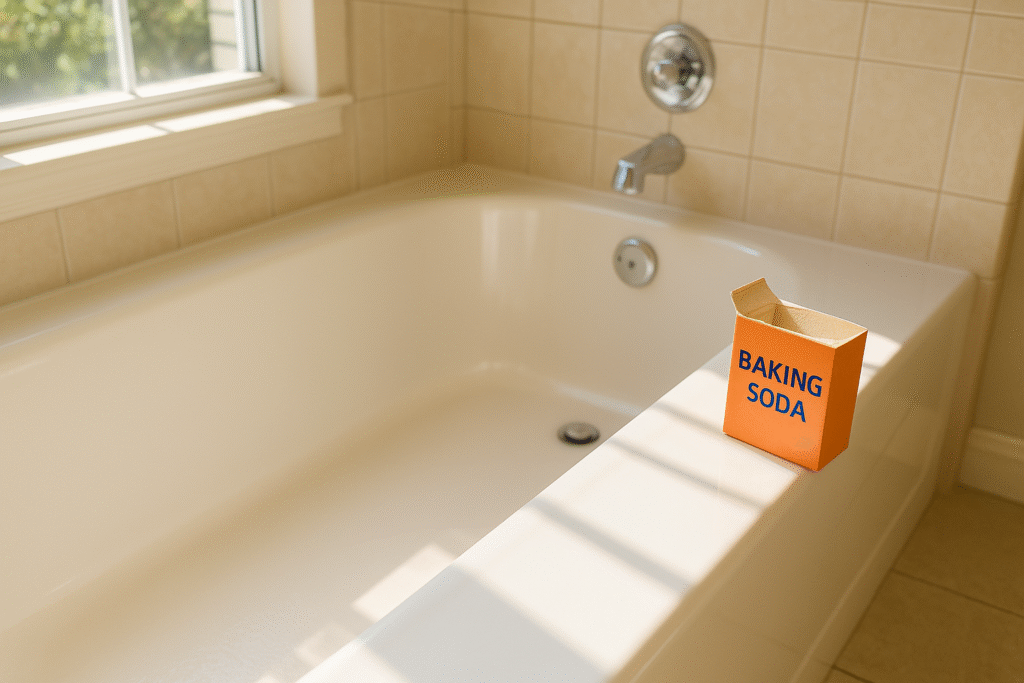
 Read Similar Topics
Read Similar Topics
Share this:
- Click to share on Facebook (Opens in new window) Facebook
- Click to share on X (Opens in new window) X
- Click to share on LinkedIn (Opens in new window) LinkedIn
- Click to share on Reddit (Opens in new window) Reddit
- Click to share on X (Opens in new window) X
- Click to share on Threads (Opens in new window) Threads
- Click to share on WhatsApp (Opens in new window) WhatsApp

